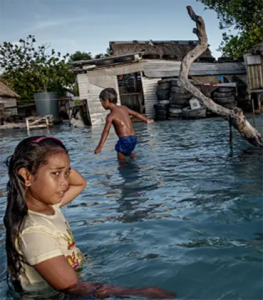Little progress on climate migration
More than 200 million people are likely to migrate over the next three decades because of extreme weather events or the slow degradation of their environments, according to a new World Bank report.
Most will be displaced within their home country, but about a quarter of the people who flee will cross borders, seeking a better life in a different land, the report says.
 It says that in Bangladesh, hundreds of thousands of people are displaced every year by larger and more unpredictable monsoon floods, a trend throughout the region, which more than eight million people have left in recent years.
It says that in Bangladesh, hundreds of thousands of people are displaced every year by larger and more unpredictable monsoon floods, a trend throughout the region, which more than eight million people have left in recent years.
And in West Africa’s Sahel region, heavy floods and food shortages have combined with violence and instability to drive people to other regions. In the Caribbean, massive hurricanes regularly push residents out of their homes, the report says.
And rather than being a future concern, climate change-driven migration and displacement are already taking place. A majority of the 30.7 million people displaced in 2020 were fleeing floods, wildfire, drought or heat waves, according to another report released recently by the International Federation of Red Cross and Red Crescent Societies.
But the World Bank report points out that international law has no clear mechanism to process, address or facilitate climate migration.
The 2015 Paris climate agreement called for a task force on climate migration, and the 2018 U.N. global compact for migration cited climate change as one factor in outlining the need for protection of those on the move. Yet climate migrants do not easily qualify as refugees, and so are not granted the same rights and protections.
The recent COP26 conference in Glasgow heard from people already displaced by climate change; it featured presentations on mitigation practices and research from countries and regions already experiencing mass displacement.
But there was no progress on legal mechanisms to protect climate migrants and the official schedule
Some countries have already broadened their own definition of refugee law beyond the 1951 convention.
The African Union’s Refugee Convention, signed in 1969, expanded the definition of refugee to include every person who is compelled to leave home “owing to external aggression, occupation, foreign domination or events seriously disturbing public order.”
Legal scholars have argued that the clause about public order could be used for those fleeing climate change disasters. The 1984 Cartagena Declaration on Refugees, signed by several countries in Latin America, similarly includes a clause about public order.
Consecutive United Nations climate conferences and migration treaties have stressed the need for legal protections for people displaced due to climate change and laid out principles for these protections. But they have stopped short of agreeing on any concrete or binding measures to address climate migration.
After several climate conferences in the early 2000s, for instance, Norway and Switzerland in 2011 created a process called the Nansen Initiative, which created a “protection agenda” for people displaced by climate change.
This agenda was endorsed by 109 nations in 2015, but it is not binding on the nations that signed onto it. In 2016, however, several countries created the Platform on Disaster Displacement, an initiative that works with states to implement the recommendations of the agenda.
One idea that has emerged in response to forced climate migration are Free Movement Agreements – or compacts between countries that allow people to move more liberally, sometimes without visas, and include provisions for work or other social rights.
These agreements operate in the Caribbean and allowed people displaced by hurricanes in 2017 to move more safely, to access labour markets and sometimes to stay in a new location long-term.
Movement Agreements could be part of the policy response to climate migration as they can bypass political hurdles to creating a new international treaty and provide stable solutions for those on the move.
To work, wealthy countries like Australia would have to include smaller, poorer island nations in a free movement agreement.












